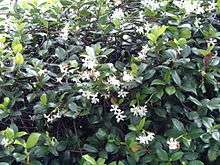Trachelospermum jasminoides
| Trachelospermum jasminoides | |
|---|---|
 | |
| Scientific classification | |
| Kingdom: | Plantae |
| (unranked): | Angiosperms |
| (unranked): | Eudicots |
| (unranked): | Asterids |
| Order: | Gentianales |
| Family: | Apocynaceae |
| Genus: | Trachelospermum |
| Species: | T. jasminoides |
| Binomial name | |
| Trachelospermum jasminoides (Lindl.) Lem. | |
| Synonyms | |
|
Rhynchospermum jasminoides Lindl. | |
Trachelospermum jasminoides is a species of flowering plant in the family Apocynaceae, native to eastern and southeastern Asia (Japan, Korea, southern China and Vietnam).[1] Common names include confederate jasmine,[2] star jasmine,[3] confederate jessamine,[3] and Chinese star jessamine.[3]
Description
Trachelospermum jasminoides is an evergreen woody liana growing to 3 m (10 ft) high. The leaves are opposite, oval to lanceolate, 2–10 cm (3⁄4–3 7⁄8 in) long and 1–4.5 cm (3⁄8–1 3⁄4 in) broad, with an entire margin and an acuminate apex.
The fragrant flowers are white, 1–2 cm (3⁄8–3⁄4 in) diameter, with a tube-like corolla opening out into five petal-like lobes. The fruit is a slender follicle 10–25 cm (3 7⁄8–9 7⁄8 in) long and 3–10 mm (1⁄8–3⁄8 in) broad, containing numerous seeds.[1]
Uses
A valuable perfume oil is extracted from the steam distilled or tinctured flowers and used in high end perfumery. In a dilute form, tinctured flowers are much used in Chinese, Vietnamese and Thai incenses. A bast fibre is produced from the stems.[1]
Cultivation
Trachelospermum jasminoides is commonly grown as an ornamental plant and houseplant. In gardens, public landscapes, and parks it is used as a climbing vine, a groundcover, and a fragrant potted plant on terraces and patios. It will flower in full sun, partial shade, or total shade, and requires well-drained soil (if constantly kept damp it may succumb to fungal infection), moderate water, moderate fertilizer, and a climbing structure (whether a trellis or another plant is secondary). Propagation is most commonly done with cuttings/ clones.[4]
It is widely planted in California and also particularly in the Southeastern United States, where its hardiness, confined to USDA Zones 8–10, the area of the former Confederate States of America, gives it the name Confederate jasmine. It gets another of its common names, trader's compass, from an old Uzbekistan saying that it pointed traders in the right direction, provided they were of good character. It is also called star jasmine in Europe and Chinese jasmine or Chinese ivy in Asia.
This plant,[5] and the variegated cultivar 'Variegatum',[6] have gained the Royal Horticultural Society's Award of Garden Merit. Its irritating, milky latex-like sap makes it resistant to the depredations of Australian possums.[7]
 Plant in flower
Plant in flower- Flower closeup
 Trained on garden wall
Trained on garden wall Blooming on trellis
Blooming on trellis
References
- 1 2 3 Flora of China: Trachelospermum jasminoides
- ↑ "Trachelospermum jasminoides". Natural Resources Conservation Service PLANTS Database. USDA. Retrieved 12 December 2015.
- 1 2 3 Germplasm Resources Information Network: Trachelospermum jasminoides
- ↑ Garrett, Howard (1996). Howard Garrett's Plants for Texas. University of Texas. p. 157. ISBN 9780292727885.
- ↑ "RHS Plant Selector - Trachelospermum jasminoides". Retrieved 6 June 2013.
- ↑ "RHS Plant Selector - Trachelospermum jasminoides 'Variegatum'". Retrieved 6 June 2013.
- ↑ Miller, Ming, horticulturalist, Bunnings Box Hill (pers comm 29 Dec 2013)
Further reading
| Wikimedia Commons has media related to Trachelospermum jasminoides. |